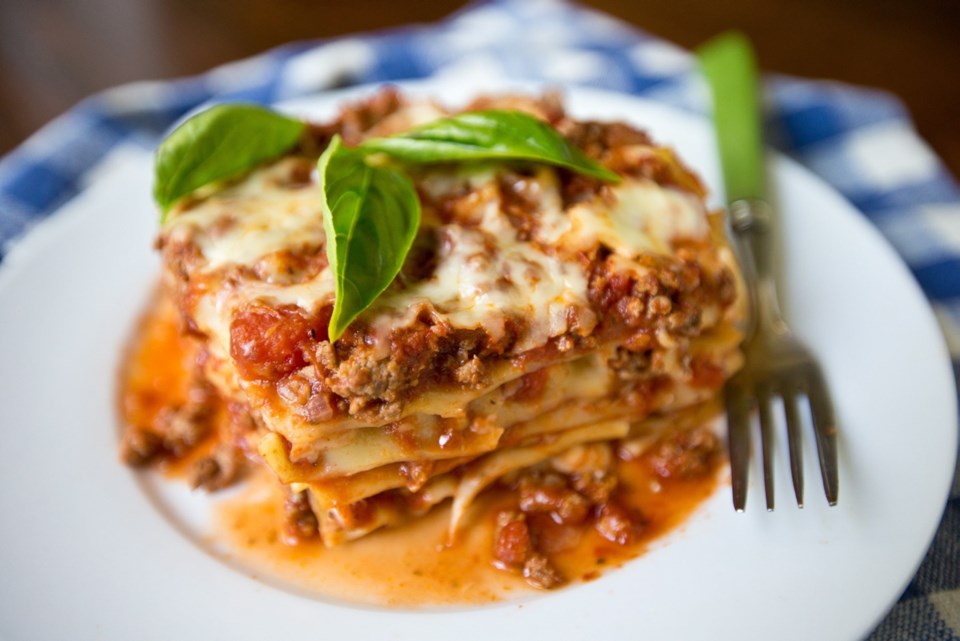 Dear Eric: I wonder if you have a recipe for lasagna with meat sauce? I would like one with lots of sauce, as mine sometimes turns out dry.
Dear Eric: I wonder if you have a recipe for lasagna with meat sauce? I would like one with lots of sauce, as mine sometimes turns out dry.
Doreen
Dear Doreen: In the summer, after too many barbecue suppers, I’ll get cravings for foods I love, but identify as being better suited to cooler times of the year.
I’m talking about hearty dishes that simmer and bake and require you to fire up the stove and heat up your house.
Meaty lasagna is one of those dishes and when Doreen’s query came in, duty called and gave me licence to ignore the warm weather and make a bubbly and delicious one.
I’m glad I did because, served with a simple green salad, it made a lovely meal for three family members and me. Also, because my lasagna yields at least eight portions, there were leftovers, which I froze to thaw and reheat for a meal later in the summer.
My recipe layers a generous two litres or so of meat sauce between its four layers of noodles. That amount keeps the lasagna quite moist during and after baking, but not so wet and sloppy you can’t neatly slice it when ready to serve. Also helping keep my lasagna moist was the fact that I used dried lasagna noodles I boiled myself, not the dried, oven-ready, no-boiling-required type sold at most supermarkets.
While the latter are convenient, I don’t care for them because I find that as those dry noodles cook and soften inside the lasagna as it bakes, they absorb too much of the sauce, causing the lasagna to be dry and unappealing in texture when ready.
When boiling the noodles for lasagna, bring at least three litres of water to a boil in a deep pot and add two to three teaspoons of salt.
Using lots of water prevents the pasta from sticking together as it cooks, meaning there’s no need to add oil to the water as some cooks do. In fact, adding oil makes the pasta slick, which prevents the tasty sauce from clinging to it.
Using a deep pot makes it easier to submerge the noodles, and as the pasta cooks, it absorbs the salt, seasoning it and contributing to the overall flavour of the lasagna.
I used three types of ground meat in my lasagna: beef, pork and veal, which gave it a rich and robust flavour that meat eaters will enjoy. That said, Doreen, if desired, you could keep things simple and forget the pork and veal and just use beef in this recipe.
Meat Lover’s Lasagna
Because I layered so much sauce into this lasagna, I used a deep, 13- x 9-inch casserole, about three inches tall, to accommodate the sauce, noodles and cheese.
Preparation time: 40 minutes
Cooking time: About 105 minutes
Makes: eight to 12 servings
1/2 lb. lean ground beef
1/2 lb. ground pork
1/2 lb. ground veal
1 large onion, finely chopped
2 garlic cloves, minced
2 tsp dried oregano
1 (28 oz.) can diced tomatoes
1 (28 oz.) can crushed tomatoes
1 1/4 cups beef stock or red wine, or a mix of both
1/2 tsp sugar
• salt and freshly ground pepper to taste
20 dried lasagna noodles (see Note)
1 lb (454 grams) mozzarella cheese, grated
1/4 cup freshly grated Parmesan cheese (not the dried, powdered stuff)
• fresh basil leaves, to taste, for garnish (optional)
Place the ground meats in a large pot and cook over medium heat, stirring occasionally, until cooked through and crumbly. Drain away the excess fat and liquid.
Set the pot back over the heat, add the onion, garlic and oregano, and cook five minutes more. Add the canned tomato products, stock (or wine) and sugar. Bring the sauce to a gentle simmer (small bubbles should just break on the surface) and loosely cover (don’t completely cover, as steam needs to escape).
Simmer the sauce for 30 minutes, then season with salt and pepper. While the sauce simmers, set a large pot of water over medium-high heat and bring to a boil.
Salt the water, and then add the noodles and cook until just tender, but still a little firm, about eight minutes. (When cooked, a lasagna noodle should resist slightly when you bite into it.) Drain the noodles well, cool in cold water and then drain well again.
Preheat the oven to 350 F. To assemble the lasagna, start by spooning 1 1/2 cups of the meat sauce into a 3-inch deep, 13- x 9-inch baking dish. Top the sauce with five lasagna noodles, overlapping them.
Top the noodles with a quarter (about 1 1/2 cups) of the remaining sauce. Sprinkle the meat sauce with a quarter of the mozzarella cheese. Repeat these three steps three more times.
Sprinkle the top of the lasagna with the Parmesan cheese. Tent and cover the top of the lasagna with aluminum foil, and then bake in the middle of the oven 45 minutes. (If desired, place a baking sheet with some water in it on the rack below the lasagna, just in case it bubbles over the sides of the pan.)
After 45 minutes of baking, uncover the lasagna and bake uncovered for 10 to 15 minutes more, or until the top is golden and the lasagna is bubbly.
Let the lasagna rest at room temperature for 10 minutes, and then cut and serve. If desired, garnish each serving of lasagna with a few fresh basil leaves.
Note: One 500-gram box of lasagna noodles should contain the 20 required for this recipe.
Eric Akis is the author of The Great Rotisserie Chicken Cookbook (Appetite by Random House). His columns appear in the Life section Wednesday and Sunday.



